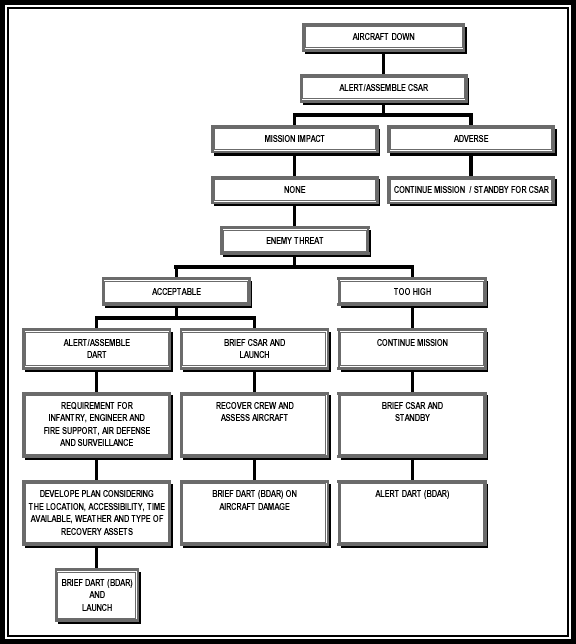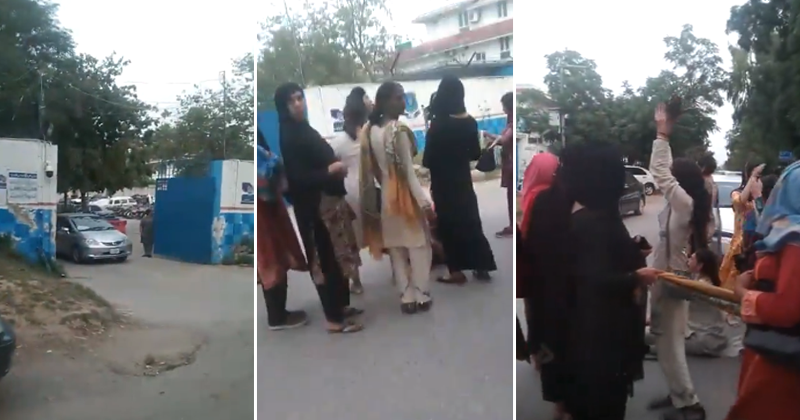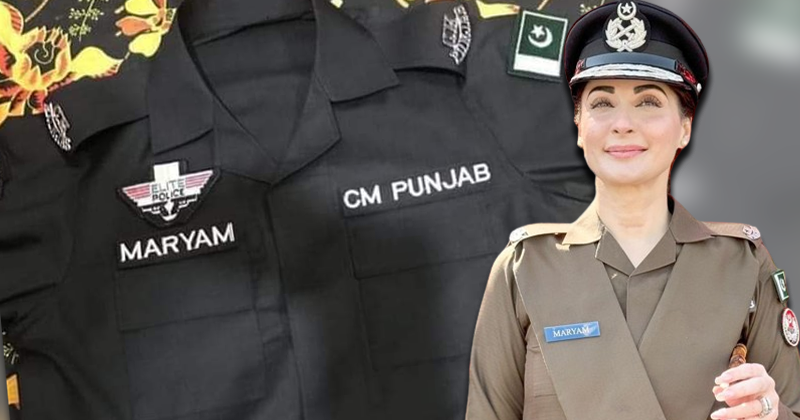This is not the Whole Manual, just a small part, to show process involved for Down Aircraft.
Field Manual No. 3-04.513
Headquarters Department of the US Army
FM 3-04.513
Battlefield Recovery and Evacuation of Aircraft
Chapter 1
Section
BATTLEFIELD MANAGEMENT
1-1. Historically, the effort at recovering aircrews or aircraft off the battlefield has been minimal and poorly coordinated at best. Today, CSAR and DART/BDAR provide the methods for retrieving aircrews and aircraft as well as regenerating those resources necessary to maintain momentum on the battlefield. FM 3-04.113(1-113), chapter 7, provides commanders guidance on CSAR missions. Army and Joint CSAR procedures can be found in Joint Publication (JP) 3-50.2, Doctrine for Joint Combat Search and Rescue, and in JP 3-50.21, Joint Tactics, Techniques, and Procedures for Combat Search and Rescue. Airspace control can be found in JP 3-52, Doctrine for Joint Airspace Control in the Combat Zone.
EXTRACTION/RECOVERY PRIORITIES
GENERAL
1-13. Aircraft recovery operations can be placed into two separate categories: Immediate or delayed. Commanders must recognize and prepare for both types of recovery operations.
IMMEDIATE RECOVERY
1-14. Immediate recovery of the aircraft is possible when the aircraft at the scene of the forced landing can be assessed, fixed, and returned to service, or prepared for a one-time evacuation mission to a maintenance site in a minimal amount of time. The time required to repair the aircraft or rig it for recovery at the scene depends on the tactical situation and condition of aircraft, which may result in a delayed recovery operation.
(Example: During an air assault, an aircraft can be recovered immediately by having an aircraft in the flight follow a downed aircraft to rescue the flight crew and/or assess the aircraft damage or maintenance problem. If the problem can be fixed rapidly, the aircraft may be returned to service or prepared for a one-time evacuation mission to a maintenance site. Immediate recovery is the most effective method for recovering downed aircraft if the damage is not extensive.)
1-15. Immediate recovery is desirable because friendly aircraft usually are in the area and enemy forces probably have not had the opportunity to react. The commander must consider certain factors when planning for immediate recovery such as
Continuation of Mission. Immediate recovery may take aircraft away from the primary mission. Commanders must consider the intent of the mission and decide if it is feasible to take an aircraft away from an ongoing mission to conduct immediate recovery mission. If the mission is an air assault, the aviation commander must consult with the air assault task force commander (AATFC) before executing immediate recovery. The aviation commander may designate an aircraft, piloted by maintenance officers, to conduct immediate recovery if required.
Pickup Aircraft. Commander may designate specific aircraft, crewed by maintenance personnel, with the responsibility to conduct immediate recovery, or the responsibility may fall on the nearest aircraft in support of the downed aircraft. The commander must specify and select the aircraft to be used for immediate recovery during the planning process. The selected crew must receive specific, detailed instruction on the execution of an aircraft recovery.
Recovery Aircraft Location. The aircraft designated for immediate recovery may be part of the mission and formation, or it may be an additional aircraft. The recovery aircraft should be positioned where it can best support the mission.
Army Airspace Command and Control. Separate airspace control measures may be developed to allow DART aircraft to recover the aircraft without interfering with the ongoing mission. If the DART aircraft is designated as part of the mission fleet, effective C2 must be established to de-conflict aircraft.
1-2. According to FM 3-04.113(1-113), the CSAR task force (TF) commander executes the extraction of personnel followed by the recovery of equipment. This is true when both personnel and equipment are at the same location. Aircraft extracting personnel (for example, UH-60 Black Hawk) should be cleared into the extraction site immediately after the area has been secured. Equipment recovery operations may be conducted simultaneously with the personnel extraction operation or delayed until the personnel extraction has egressed the extraction site. In either case, any aircraft ingressing the extraction/recovery site will remain off-station until specifically cleared for the approach by the CSAR TF commander. Conversely, any aircraft egressing the extraction/recovery site will remain at the site until cleared for departure by the CSAR TF commander.
1-3. Simply stated, the extraction and recovery priorities are recovery of the aircrew and simultaneous evaluation of the aircraft. Determine if the aircraft is still an asset. If so, secure the aircraft or area, evacuate the aircraft, and repair the aircraft.
Chapter 2
General Recovery and Evacuation Procedures
Section 2.6
BATTLEFIELD RECOVERY
2-6. Battlefield aircraft recovery is an operation that results from an aircraft having experienced a component-failure-induced or combat-damage-induced forced landing on the battlefield, or the aircraft is disabled because of an accident. Based on an assessment, the aircraft might be destroyed or abandoned, repaired and flown-out, or recovered to a maintenance site either by aerial or ground means.

Field Manual No. 3-04.513
Headquarters Department of the US Army
FM 3-04.513
Battlefield Recovery and Evacuation of Aircraft
Chapter 1
Section
BATTLEFIELD MANAGEMENT
1-1. Historically, the effort at recovering aircrews or aircraft off the battlefield has been minimal and poorly coordinated at best. Today, CSAR and DART/BDAR provide the methods for retrieving aircrews and aircraft as well as regenerating those resources necessary to maintain momentum on the battlefield. FM 3-04.113(1-113), chapter 7, provides commanders guidance on CSAR missions. Army and Joint CSAR procedures can be found in Joint Publication (JP) 3-50.2, Doctrine for Joint Combat Search and Rescue, and in JP 3-50.21, Joint Tactics, Techniques, and Procedures for Combat Search and Rescue. Airspace control can be found in JP 3-52, Doctrine for Joint Airspace Control in the Combat Zone.
EXTRACTION/RECOVERY PRIORITIES
GENERAL
1-13. Aircraft recovery operations can be placed into two separate categories: Immediate or delayed. Commanders must recognize and prepare for both types of recovery operations.
IMMEDIATE RECOVERY
1-14. Immediate recovery of the aircraft is possible when the aircraft at the scene of the forced landing can be assessed, fixed, and returned to service, or prepared for a one-time evacuation mission to a maintenance site in a minimal amount of time. The time required to repair the aircraft or rig it for recovery at the scene depends on the tactical situation and condition of aircraft, which may result in a delayed recovery operation.
(Example: During an air assault, an aircraft can be recovered immediately by having an aircraft in the flight follow a downed aircraft to rescue the flight crew and/or assess the aircraft damage or maintenance problem. If the problem can be fixed rapidly, the aircraft may be returned to service or prepared for a one-time evacuation mission to a maintenance site. Immediate recovery is the most effective method for recovering downed aircraft if the damage is not extensive.)
1-15. Immediate recovery is desirable because friendly aircraft usually are in the area and enemy forces probably have not had the opportunity to react. The commander must consider certain factors when planning for immediate recovery such as
Continuation of Mission. Immediate recovery may take aircraft away from the primary mission. Commanders must consider the intent of the mission and decide if it is feasible to take an aircraft away from an ongoing mission to conduct immediate recovery mission. If the mission is an air assault, the aviation commander must consult with the air assault task force commander (AATFC) before executing immediate recovery. The aviation commander may designate an aircraft, piloted by maintenance officers, to conduct immediate recovery if required.
Pickup Aircraft. Commander may designate specific aircraft, crewed by maintenance personnel, with the responsibility to conduct immediate recovery, or the responsibility may fall on the nearest aircraft in support of the downed aircraft. The commander must specify and select the aircraft to be used for immediate recovery during the planning process. The selected crew must receive specific, detailed instruction on the execution of an aircraft recovery.
Recovery Aircraft Location. The aircraft designated for immediate recovery may be part of the mission and formation, or it may be an additional aircraft. The recovery aircraft should be positioned where it can best support the mission.
Army Airspace Command and Control. Separate airspace control measures may be developed to allow DART aircraft to recover the aircraft without interfering with the ongoing mission. If the DART aircraft is designated as part of the mission fleet, effective C2 must be established to de-conflict aircraft.
1-2. According to FM 3-04.113(1-113), the CSAR task force (TF) commander executes the extraction of personnel followed by the recovery of equipment. This is true when both personnel and equipment are at the same location. Aircraft extracting personnel (for example, UH-60 Black Hawk) should be cleared into the extraction site immediately after the area has been secured. Equipment recovery operations may be conducted simultaneously with the personnel extraction operation or delayed until the personnel extraction has egressed the extraction site. In either case, any aircraft ingressing the extraction/recovery site will remain off-station until specifically cleared for the approach by the CSAR TF commander. Conversely, any aircraft egressing the extraction/recovery site will remain at the site until cleared for departure by the CSAR TF commander.
1-3. Simply stated, the extraction and recovery priorities are recovery of the aircrew and simultaneous evaluation of the aircraft. Determine if the aircraft is still an asset. If so, secure the aircraft or area, evacuate the aircraft, and repair the aircraft.
Chapter 2
General Recovery and Evacuation Procedures
Section 2.6
BATTLEFIELD RECOVERY
2-6. Battlefield aircraft recovery is an operation that results from an aircraft having experienced a component-failure-induced or combat-damage-induced forced landing on the battlefield, or the aircraft is disabled because of an accident. Based on an assessment, the aircraft might be destroyed or abandoned, repaired and flown-out, or recovered to a maintenance site either by aerial or ground means.
































